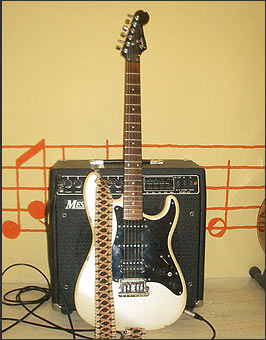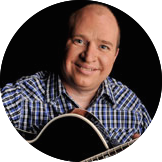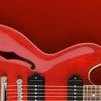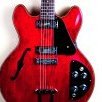-
Posts
243 -
Joined
-
Last visited
-
Days Won
19
Content Type
Profiles
Forums
Gallery
Events
Articles
Blogs
Downloads
Everything posted by Fretless
-

Session 4: My experience with Session 4.
Fretless replied to BillV's topic in Gibson's Learn & Master Guitar
That is good to hear, Bill. All the best for revision times in the first 4 sessions and for enjoyable progress through session 5. -
Someone asked me recently about play along CDs and the tempos. I doubt this comes up often and knowing how to find the list may not be intuitive as this topic seems to get pinned and unpinned at times - and there are a lot of pinned topics. Search for any of the song titles on the 5 CDs and it will be in the search results.
-
Thank you for telling us that, Gene, as it reminded me to buy the workout, something I wanted to do but had forgotten about.
-
That is a great choice, Gary, and a lovely story too, letting the guitar speak to you as you tried it out. I trust your wife will not regret encouraging you to buy this one.
-

Playing without strumming
Fretless replied to RollingCodeGuits's topic in Guitar Playing & Technique
Hello. That technique is called tapping. It is popular mostly in two genres: the acoustic style as Marcin Patrzalek demonstrates in the video, and also heavy metal - check out Eddie Van Halen's song Eruption as just one example. -
Warmouth is the standard against which all others are compared - and there are quite a lot of similar companies so do look around to see what is on offer. I am not sure whether you can buy complete kits from Warmouth and the others at the quality end of the market, just top quality bodies and necks, raw or finished as per your wishes. Thomann, for example, sells cheap kits that might be a good starting point as you get everything, albeit at a lower quality level.
-
The EL84 tubes will wear out every few years, and they need to be a matched pair so change them both at the same time. If that doesn't fix your problem, at least you have a spare pair at hand, so all is well. When you order your EL84s, you might like to also order at least one 12AX7. These usually last many years if not a lifetime, but being able to swap out the 5 12AX7 tubes one at a time to see what difference that makes will help you identify which tube, if any, is at fault. If neither of the above fix it then an authorized Mesa repairer will be the place to go. As you are in the USA you might like to try Doug's Tubes at https://www.dougstubes.com as many Mesa users comment on how quiet his Tubes are. Tell him which amp you are buying tubes for. I am not in the US so I have never bought from Doug so I do not speak from personal experience.
-
Congratulations, matonanjin. I am of the oipinion that everyone needs at least one Tele, after all, it is the multi-purpose do-it-all guitar.
-
That is great news, indeed! Walnut will help give each string its own clear sound so that should be more of a crisp and clear sound rather than a warm, possibly muddy sound. For strings you might like to try and compare 3 sets: whatever you have been happy with on your Fender FA-100, a set of phospher bronze, because they are pretty mush the benchmark for acoustic guitars, and a set of silk and steel which will give a mellower sound than phosper bronze. My guess is that while the guitar is new and has a brighter natural sound, silk and steel may turn out to be your preferred choice, and then after a few years, as the wood starts maturing and mellowing (my 1997 Takamine took 9 years before I noticed the change), a move to phospher bronze might be worth trying again. I hope that child at Christmas feeling lasts a very, very long time.
-
Well done, Greg! It is nice to see you in action having heard you so many times.
-
So, matonanjin, how is life with your two new acoustic guitars now a couple of months have passed? Do you find yourself playing one more than the other?
-
More so with acoustics than electrics it is important to go and try these guitars before you buy because wood varies depending on the particular tree it came from and what weather that tree has had through its life. A few years ago I wanted to buy a guitar as a gift for a great children's worker I worked with one summer. His faithful old guitar was a mess. I went to my local guitar shop and headed straight for the Yamaha and Fender acoustics. I was a bit surprised that the sound was okay but not seductive and they weren't finished or set up as I would have hoped. I started trying some others in the shop and I stumbled on a pretty unknown brand (Klema) and it was like velvet in my hands, so nicely made, so easy to play and the sound was beautiful. That was 400 euros, not a lot short of USD$500. I am not suggesting you hunt down a Klema but go into a shop with a good selection of electro-acoustic guitars and be prepared to find which guitar feels and sounds perfect for you. And don't forget to let us all know what you get!
-
Hello Nairon, Rosewood has been a standard for many years and creates a warmer sound than maple fretboards. Some rosewood species are becoming endagered and that restricts their availability. Alternatives are being tried, including the two you mention, baked maple and even manmade fingerboards such as Richlite and Micarta. Expect rare species on only top end guitars and other rosewppd species on guitars across all quality and price bands. Ovangkol is said to be a relatove of rosewood and so will have similar properties. Given that not all species of rosewood are thought of as the pinnacle of guitar sounds, I expect ovangkol to be used on mid-range (and thus mid-priced) guitars. Laurel fingerboards are already available on some guitars, pretty much all at the budget end of the market, so read into that what you will. I have not played a laurel fingerboard but with today's guitar-making technology even budget guitars are better made than many were 40 or more years ago. The question will be how does it contribute to the guitar's sound along with other budget-priced woods on a budget guitar, and in what condition will it be in after years of continuous use. That I am not sure. As far as bridges go, I have to admit that I don't have any specific knowledge or experience to push you in one direction other than the harder the wood the more likely it is to get the string vibrations to the guitar top with less damping or colouration of the sound. I tend to think of ebony and rosewood but I expect I can be shown to be out-of-date as other tested and proven woods crop up with increasing frequency. What sort of guitar are you looking for and what sort of music do you play?
-

NGD Part Deux Martin 000-15M!
Fretless replied to matonanjin's topic in Guitar Gear, Amps, Effects, Pedals
I don't have a mahogany guitar but I do have a mahogany ukelele bass which produces a lovely full tone. I wholly agree and approve of mahogany instruments. -

NGD Part Deux Martin 000-15M!
Fretless replied to matonanjin's topic in Guitar Gear, Amps, Effects, Pedals
That is a terrific contrast to the M-36, you really have chosen wisely. -
That is a great story: you were thorough, diligent and yet open to a great guitar you had not considered. Wonderful! Now, what n+1 guitar are you going to buy with the money you saved not getting the EC?
-
Pickups that do not use batteries are called passive. Pickups that require batteries are called active. All preamps are active so need batteries. Many preamps are installed in the guitar (in the block that houses the volume and tone controls) because the cable length from pickup to preamp should ideally be short. There are external preamps which are used to improve the quality of passive pickups. In your guitar, if there are no batteries then you have a passive pickup. A battery compartment should be obvious, either because it has its own hole in the back or side of the body (anywhere on that round back on your Ktone guitar) or a small door on the control panel, which looks to me as though that is not the case on your guitar. If you are happy removing the control panel that will give you access to see what is going on inside (with a torch and maybe a small mirror). It may be that a soldered joint has dried out or a component has failed. Either check for yourself or get a local guitar technician to check, although I suspect that getting someone else to do it will be more expensive than the guitar as Ktone guitars are, unfortunately, not of high quality, which is perhaps why they are no longer made. If you have a good guitar you may feel it is worth repairing or replacing the electronics. Companies like K&K, Fishman and L. R. Baggs all make quality pickups for acoustic guitars. The challenge will be finding a control panel that fits your guitar - or a slightly larger one and expand the size of the hole to match. Do let us know what you discover and how you choose to proceed.
-
Nairon, The best use of your budget will be to spend 50% on gear and 50% on acoustic treatment for your room. More on this in a minute. The Scarlett Solo, 2i2 and similar 2-channel audio interfaces are great for home users because they are of high enough audio quality, audio routing in and out, and robustly enough made. These open the door to being able to use most of the microphones on the market. Choosing a USB mic negates the need for an audio interface but that will confine you to just that mic. It is not a wise route to go unless your total budget is so small that you cannot even afford good value budget equipment. Probably the most popular home recording mic is the Rode NT1-A. If your budget permits getting a bundle that includes a shock mount and (maybe separately) a microphone stand and an XLR cable, that will set you up for a good start. A second mic, when you are ready, will provide further recording options, be it one sound recorded in stereo or a second sound source, eg. voice and acoustic guitar. Headphones. My opinion is that bundled headphones tend to be cheap (and nasty). If you can afford a pair of BeyerDynamic DT-770, Sony MDR-7506 or something that appeals to you at that price and quality point then you will not need to upgrade them ever. When you sing or play, sound bounces around the room, creating reverb (which is lots of relections of the original sound) - a tiled bathroom more than a room with lots of curtains and cushions. Microphones pick up (ie. record) sound that reaches the mic. In an ideal recording environment you want to record the sound coming directly from the voice or guitar but not the reflected sounds. Because home rooms are small the resulting recording will have a small, boxy sound. This is why the wisest advice is to commit 50% of your budget to acoustic treatment. As you purchase more gear, also purchase (or make) more acoustic treatment. This will start blocking the reflected sounds, leaving a purer recording. Companies like GIK Acoustics sell ready-made traps (called that because they trap the sound like a sponge would trap spilled water). It is not difficult to make your own which can be much cheaper. I can explain if you are interested. Why should you trust me, someone you don't know? Don't. Read further and discover these truths for yourself. Everyone has their opinion, their favourite piece of equipment. Me too. Once you start to notice many people (not from the same cluster) recommending the same direction, you can be more confident of the path being suggested.
- 59 replies
-
- interfaces
- daw
-
(and 3 more)
Tagged with:
-

Spring, and life is beginning to bloom again..
Fretless replied to gotto's topic in Guitar Open Talk
Over here in mainland Europe we are still in lockdown, as of last week it has been extended another 40 days. That makes it impossible to get out other than to the doctor or the nearest food shop. Still, that doesn't stop me looking forward to the day we can start to meet, rehearse and perform again. Keep well, keep safe, keep healthy, one and all. -
You can usually change the valve (tube) in slot 1 to a less powerful one to get a quieter sound. I have done it in my Fender '57 Custom Reissue, changing the 12AX7 for a 12AY7 but I don't know what a 65 Deluxe Reverb can use, probably a 12AY7 or a 12AT7.
-

Is this course ever going to be available online?
Fretless replied to BrokenSpoke's topic in Gibson's Learn & Master Guitar
Handbrake is open source software and free. https://handbrake.fr/downloads.php -

Is this course ever going to be available online?
Fretless replied to BrokenSpoke's topic in Gibson's Learn & Master Guitar
I used Handbrake to rip the DVDs (on my computer) so that I can have the course on my iPad. -
Hang on a moment Eduardo, I was thinking you had so many instruments between you but now you say your wife is not a musician. What is that telling us about the owner of all those instruments? By the way, that Guild is a wonderful guitar. Good choice!
-
My choice would be for my HSS strat as it has been the most enjoyably versatile guitar I have owned. Coupled with the Mesa Boogie which is in itself a versatile amp, the tonal possibilities I have at my disposal mean I can cover country (which really requires a Tele), jazz, rock, funk, pop and other genres with it. I appreciate Nairon is talking about his acoustic guitar and do not want to argue whether an acoustic is better than an electric as they serve different purposes. I started learning on electric and it is still my personal preference.









